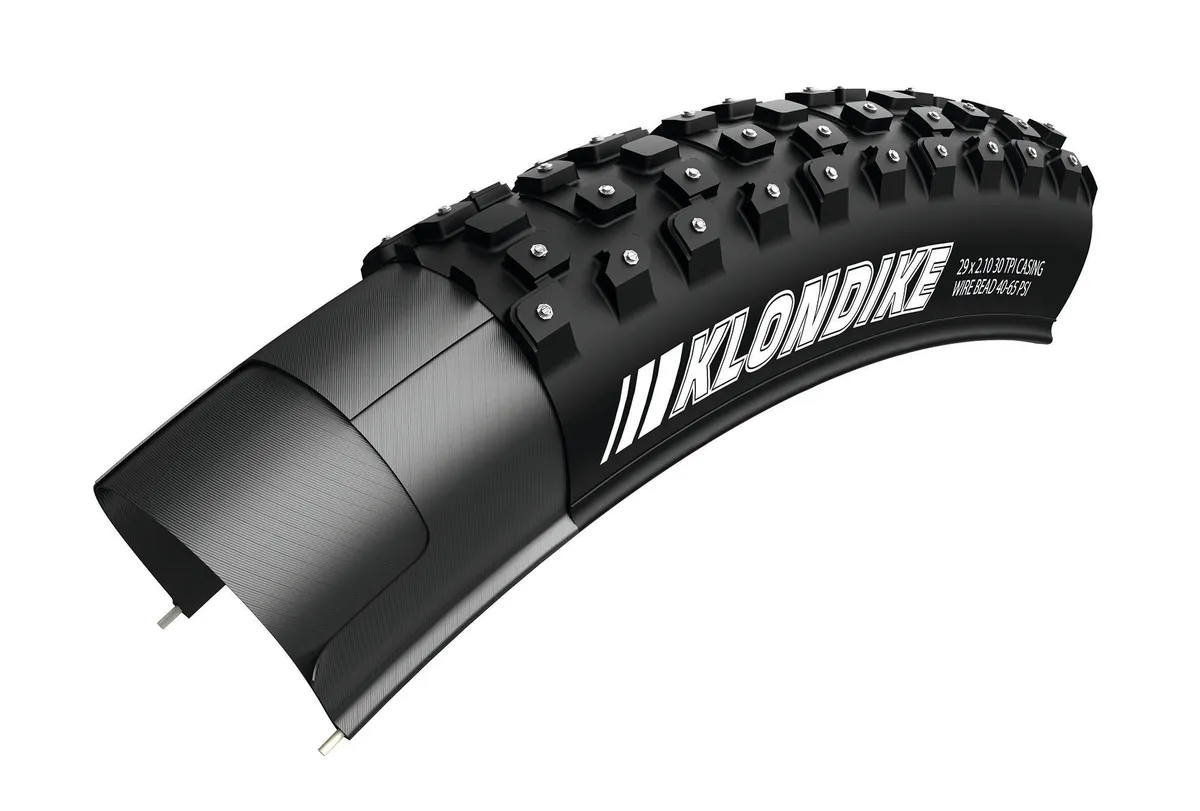Riding in the snow and ice can be difficult, if not downright dangerous.
Studded bike tyres improve control and traction in icy conditions because metal studs or spikes are embedded into the tread of the tyre.
Here, we will look at studded tyres for cycling in the snow, examine their advantages and disadvantages and outline whether you should consider using them.
We spoke to tyre expert and ex-pro mountain biker Robert Mennen from Schwalbe to hear what the brand has to say on the topic.
What are studded tyres?

Studded tyres are oddities for those living in regions that don’t experience cold weather.
Metal studs (or spikes) are embedded into the tread of the tyre. These are designed to penetrate into ice, providing traction.

These studs are usually made out of metal, with Schwalbe using a tungsten carbide tip to increase longevity.
The construction of a studded tyre is otherwise similar to a normal tyre.
What are the advantages of studded tyres?

Studded tyres provide a level of traction that no other tyre can match on ice.
The extra grip provides safer riding characteristics, with Mennen adding, “our biggest discipline for studded tyres is the commuter market, as people need the added levels of grip in the winter months.”
What are the disadvantages of studded tyres?

While studded tyres add great levels of grip on icy roads, they do come with a weight penalty – all that extra metal soon adds up.
This weight adds to the rolling mass of the bike, which can make it feel sluggish to accelerate and slow up hills.
While the extra weight might feel sluggish, Mennen says Schwalbe’s studded tyres aren’t much slower than regular tyres.
“When we tested the rolling resistance of our studded tyres, they scored very similar to our Addix Ultra Soft compound we use for downhill mountain bike tyres,” Mennen explains.
He adds that “when riding on snow, you also need to compress [the snow] down, which requires extra effort.”
Having metal in contact with the road can also make your bike sound a bit like a tank. Most tyres will have studs added to the shoulders and middle of the tyre, leaving the crown clear for better rolling resistance and reduced noise.
Studded tyres can be quite expensive because the manufacturing process is more involved.
Schwalbe’s Marathon Winter tyre costs £58.99 at RRP, which is around £20 more expensive than its studless counterpart. A Continental Contact Spike is similar at £54.99 RRP, compared to £34.99 for the regular tyre.
Mennen says riders can expect approximately four seasons of use from Schwalbe's studded tyres.
Studded tyres also require a running-in period in order to make sure all the studs are seated properly in the tyre. Schwalbe recommends a 40km ride on asphalt for its tyres, and also sells a tool for manually fixing the studs into place.
Can you use studded tyres on asphalt?

You don’t have to live next to an ice lake to benefit from the added grip of studded tyres.
Most studded tyres are designed to cope with mixed surface types. If you can deal with the added noise, then studs work well on icy asphalt.
However, bikes registered as motorised vehicles cannot legally use studded tyres on roads – this includes electric bikes that aren’t limited to 25km/h. This is because studs can damage road surfaces.
What pressure should studded tyres be run at?

The larger the contact patch, the more grip you will have, so running studded tyres at lower pressures will heighten grip levels.
The trade-off for more grip is more drag, though most tyres can be inflated to higher pressures to improve rolling resistance.
If you’re riding in icy conditions, it's unlikely you’ll be going at race pace, so a bit of extra effort is worth it for the added grip.
Can any tyre be studded?
Studded tyres are mainly found in two sectors – mountain bike tyres and commuter/touring tyres.
“It is unlikely you’ll see a slick studded tyre unless it was solely designed for ice rinks,” says Mennen. “Studded tyres need to be able to shed snow and reach the ice below – this is why they only feature on bikes with tread”.
Do you need studded tyres?

Where you live will determine whether you need studded tyres.
If you live where snow and ice are present for most of the winter, then studded tyres are a no-brainer bcecause riding without them may be hazardous.
For those who live in climates that experience a season of ice, it makes sense to invest in a set of ice tyres because they add a level of safety to commuting by bike. They can also open up a world of riding opportunities.
Studded tyres might not be worth the investment for those in more temperate climates that see few prolonged icy spells. If that sounds like you, you may want to consider winter road bike tyres or winter mountain bike tyres.
Can you add studs to a tyre?
It is not uncommon for people to make their own ice tyres by adding small screws to their worn-out tyres.
These creations straddle the line between clever hack and sketchy bodge, but can be an accessible way to experience ice riding on a budget. Proceed with caution.
Six studded tyres to consider
Schwalbe Marathon Winter Plus

- 240 studs
- Dynamo-compatible
- £58.99 / €74.49
Featuring 240 studs, the Schwalbe Marathon Winter Plus is based on the brand’s commuting/touring tyre and features the same SmartGuard puncture protection as its non-studded brethren.
Continental Contact Spike

- 240 or 120 studs
- Reflective stripes for added visibility
- £54.99 / $78.49 / €54.99
The Continental Contact Spike comes with the option of either 120 studs or 240 studs and is designed for mixed-surface riding. Available only in a 700c size, the Contact Spike uses Continental's SafetySystem puncture protection and is ebike certified.
Schwalbe Ice Spiker Pro

- 402 studs
- Tungsten Carbide studs
- £89.99 / $104.99 / €113.49
The Ice Spiker Pro is Schwalbe's heavy-duty studded mountain bike tyre, featuring 402 studs. Each stud features a tungsten carbide core clad in aluminium in order to keep the weight down. The large tread pattern should shed mud and snow well.
Kenda Klondike Wide

- 400 studs
- Chunky tread pattern to shed snow
- £60.98 / $69.95 / €69.90
Kenda’s Klondike Wide is a winter mountain bike tyre featuring 400 studs. Kenda says the square tread pattern allows for good snow shedding and adds grip when off-road. The Klondike is available in sizes ranging from 26in to 29in.
Bontrager Gnarwhal

- Up to 216 studs
- Fat bike expedition tyre
- £114.99 / $119.99 / €124.99
The Gnarwhal is Bontrager’s stud-ready fat tyre that will accept up to 216 studs. Bontrager says the lightweight side wall makes for a supple and strong ride. The tyre is tubeless-ready, and the tread pattern looks suitable for snowy adventures. The spikes can be purchased separately at £52.99 a box.
ReTyre Ice Racer

- 300 studs
- Modular tyre design
- £78 / $95 / 89
The ReTyre Ice Racer is a skin for the ReTyre modular system. The system is based around a slick base tyre that allows for different tread patterns to be zipped onto it.
The Ice Racer features 300 studs and a square tread that ReTyre says spring back to shed snow. The base tyre is extra, and costs £34 / $42 / €39.
